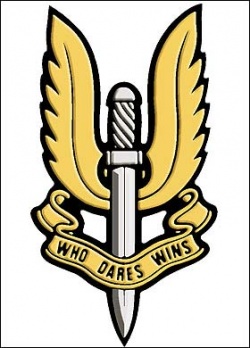Difference between revisions of "Special Air Service"
(founders) |
m (Text replacement - " has served as " to " has been ") |
||
| (4 intermediate revisions by 2 users not shown) | |||
| Line 1: | Line 1: | ||
{{group | {{group | ||
| − | |wikipedia= | + | |wikipedia=https://en.wikipedia.org/wiki/Special_Air_Service |
|logo=SAS Badge.jpg | |logo=SAS Badge.jpg | ||
|type=military | |type=military | ||
| Line 8: | Line 8: | ||
|motto=Who dares wins | |motto=Who dares wins | ||
|start=1 July 1941 | |start=1 July 1941 | ||
| + | |historycommons=http://www.historycommons.org/entity.jsp?entity=special_air_service__great_britain__1 | ||
| + | |powerbase=http://www.powerbase.info/index.php/Special_Air_Service | ||
| + | |num_staff=regiments | ||
}} | }} | ||
==Official narrative== | ==Official narrative== | ||
| − | '''The Special Air Service''' or SAS is a special forces regiment of the [[British Army]] that has | + | '''The Special Air Service''' or SAS is a special forces regiment of the [[British Army]] that has been a model for the special forces of other countries. The Special Air Service together with the [[Special Boat Service]] (SBS), [[Special Reconnaissance Regiment]] (SRR), and the [[Special Forces Support Group]] (SFSG) comprise Special Forces of the United Kingdom, under overall command of the [[Director Special Forces]]. |
The Special Air Service traces its origins to 1941 during the Second World War. It gained world wide fame after its successful assault and hostages rescue which ended the [[1980 Iranian Embassy Siege]] in London. Prior to that few outside of the military special operations community knew the regiment existed. | The Special Air Service traces its origins to 1941 during the Second World War. It gained world wide fame after its successful assault and hostages rescue which ended the [[1980 Iranian Embassy Siege]] in London. Prior to that few outside of the military special operations community knew the regiment existed. | ||
The Special Air Service comprises 21 and 22 Special Air Service Regiments of the Regular Army and 23 Special Air Service Regiment of the Territorial Army. | The Special Air Service comprises 21 and 22 Special Air Service Regiments of the Regular Army and 23 Special Air Service Regiment of the Territorial Army. | ||
| − | {{SMWDocs}}{{stub}} | + | {{SMWDocs}} |
| + | {{stub}} | ||
Latest revision as of 23:17, 2 August 2022
 | |
| Motto | Who dares wins |
| Formation | 1 July 1941 |
| Founder | |
| Parent organization | Army Reserve, UK Special Forces, UK/Army |
| Type | military |
| Subgroups | Group 13 |
| Staff | regiments |
Official narrative
The Special Air Service or SAS is a special forces regiment of the British Army that has been a model for the special forces of other countries. The Special Air Service together with the Special Boat Service (SBS), Special Reconnaissance Regiment (SRR), and the Special Forces Support Group (SFSG) comprise Special Forces of the United Kingdom, under overall command of the Director Special Forces.
The Special Air Service traces its origins to 1941 during the Second World War. It gained world wide fame after its successful assault and hostages rescue which ended the 1980 Iranian Embassy Siege in London. Prior to that few outside of the military special operations community knew the regiment existed.
The Special Air Service comprises 21 and 22 Special Air Service Regiments of the Regular Army and 23 Special Air Service Regiment of the Territorial Army.
An event carried out
| Event | Location | Description |
|---|---|---|
| Gibraltar shootings | Gibraltar | The execution of all 3 members of an IRA 'active service unit' (ASU) by British SAS soldiers in Gibraltar on 6 March 1988. Government files on the SAS shootings that should have been made available in 2015 for public scrutiny are being withheld by the Cabinet Office, which is accused of suppressing ‘politically sensitive information’. |
Employee on Wikispooks
| Employee | Job | Appointed | Description |
|---|---|---|---|
| Danny Nightingale | Soldier | 2001 | Alleged that the SAS played a role in the death of Diana. |
Related Documents
| Title | Type | Publication date | Author(s) | Description |
|---|---|---|---|---|
| Document:UK Intelligence And Security Report, 2003 | report | June 2003 | Richard M. Bennett Katie Bennett | A compendious summary of the UK Intelligence And Security agencies, including people, events and places. |
| File:Countergangs1971-76.pdf | book | November 2012 | Margaret Urwin |